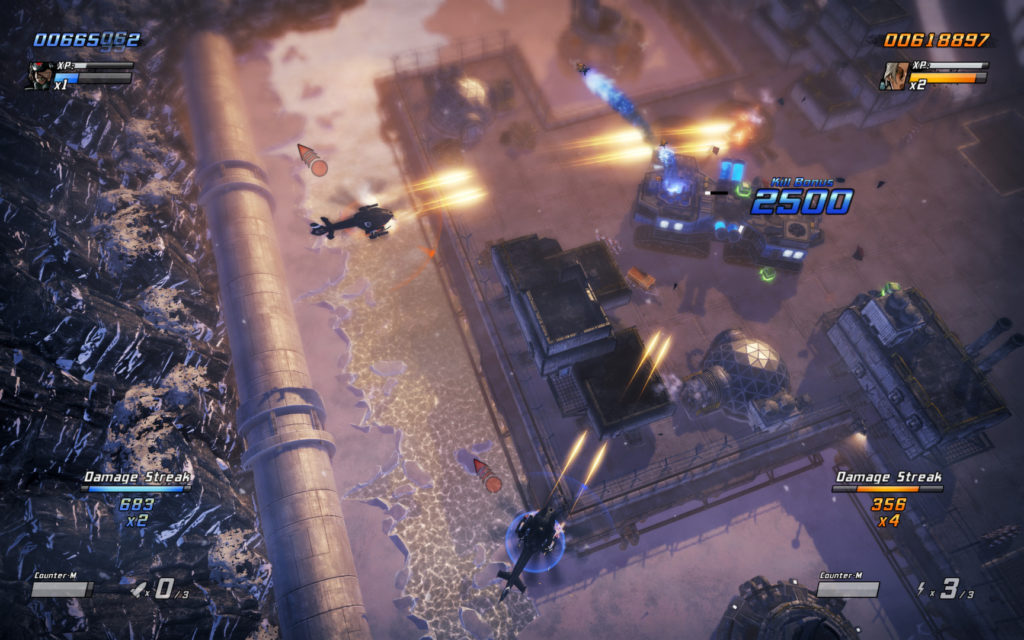The most pleasant thing about Renegade Ops is it never once tries to be what it isn’t. With clear nods to The A-Team and G.I. Joe, Renegade Ops is the spiritual sequel to each and every one of your favorite late ‘80s titles – as long as they involved cruising around and blowing shit up.
The premise is quite simple. The deranged, would-be dictator, Inferno, detonates a massive warhead, vaporizing an unnamed city in an unnamed region. Witnessing the destruction, the cowards (read: politicians) balk at the destruction, deciding to negotiate rather than retaliate. Enraged, the hotheaded General Bryant goes rogue, forming the astutely named Renegades.

Hot on the heels of Inferno, each one of Renegade Ops’ nine stages boil down to the same exact pattern: drive here, kill that. On the rare occasion you might pick up some cargo, including hostages and ‘valuable artifacts’, but even during such endeavors it still involves lots of driving and gunning. But, that’s okay, because somehow, it never gets old.
Played out from a top-down perspective, Renegade Ops evokes memories of games like Guerrilla Wars, Desert Strike and Mass Destruction. All of these games made the player feel empowered, whether by mowing down legions of faceless military enemies or leaving behind a wake of collapsed buildings. Built with the same tech as Avalanche’s previous title, Just Cause 2, the added polish and destructibility of the world provides a welcome layer of believability to Renegade Ops’ admittedly hokey story and premise. No time to divert your fire away from that tank to take out a nearby sentry tower? No problem, drive straight through it.
To make Renegade Ops digestible for today’s audience the game wisely uses the now default twin-stick shooter controls. Whipping your little buggy around the environments is a simple joy as you scoot from one objective to the next, though the controls can get touchy. Firing is handled with the right stick, which is important because the majority of combat devolves into circling enemies and firing on a centered target. This is essentially the best and only strategy for pretty much every encounter – save for airborne units – and you will use it all the time. Somehow, it still doesn’t get old.
To keep players invested beyond the initial credit roll, Renegade Ops comes fitted with local co-op for two players and online support for four. On top of that, each of the four playable renegades possesses character specific abilities and skill trees to explore. To this end, each operative can be leveled up and outfitted with two to four skills at once. Admittedly, beyond the main ability difference, the skill trees and characters don’t significantly change how one person would play Renegade Ops compared to the next: it’s still driving and shooting.

As far as multiplayer is concerned, co-op can be summed up as more guns, more mayhem. Outside of delegating a player to a different objective, there isn’t a whole lot of room for actual cooperation; you and your friend are still going to be shooting the same enemies, over and over again. This really isn’t a problem though, like Borderlands or even Gauntlet, Renegade Ops wants to get its hooks into you so you become entrenched in maxing out your character. By that account, character customization is the one trait where the game doesn’t stack up. Odds are your preferred character will have unlocked nearly the entire skill tree by the time you’ve finished the campaign, diminishing the desire to keep grinding.
What will likely keep most players invested is the simple joy of playing. Renegade Ops is a fairly conservative game, in terms of scope and originality; where it succeeds is in its execution of a well-worn game type and by transporting its players back to a simpler time. Thus, if you didn’t grow up playing arcade games jam packed with faceless villains in desperate need of killing, it’s likely a lot of Renegade Ops’ nostalgic charm might be lost. For everyone else though, it is the video game equivalent of The Expendables, except, it doesn’t suck, and it doesn’t get old.